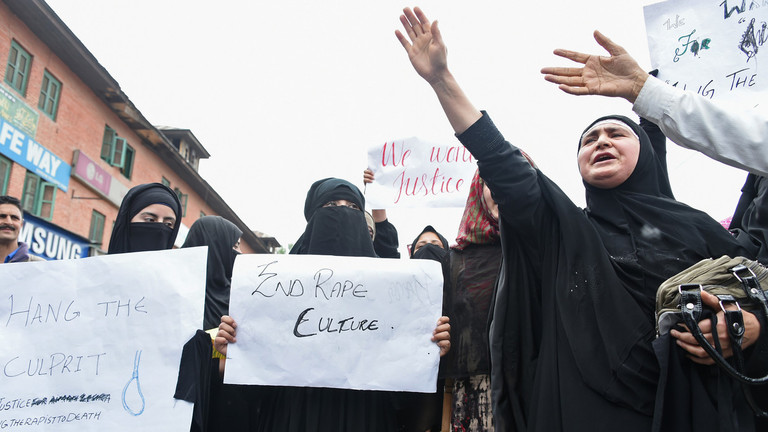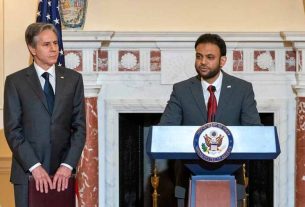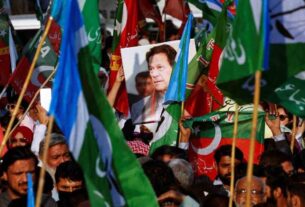Wed 15 May 2019:
The victim and the accused belong to different Muslim sects. Fears of sectarian clashes grew as fake pictures and videos began circulating on social media.
The police have refuted social media rumours that the rape accused is a minor. Soon after the incident, images began to be circulated of a handwritten birth certificate that appeared to have been issued for the accused by a local school.
However, the police said his family was yet to provide a “genuine” certificate proving that he is a minor. “From his body, physique and build, he appears to be a major,” said Malik. “We are in the process of completing the medical and other legal formalities.” Meanwhile, the police have also summoned the principal of the private school that issued the birth certificate suggesting that the accused was a minor.

Students during a protest rally in Central Kashmir’s Ganderbal district on Monday.
Sectarian tensions
While the incident has elicited widespread condemnation from across the political divide in the Valley, it has also led to fears of sectarian tension. According to the police, the victim and the accused belong to two different Muslim sects. Fears of sectarian clashes grew deeper when fake pictures and videos, apparently of the three-year-old, began circulating on social media.
The police said they had taken note of “rumour-mongers” and had “called up” the administrators of several social media accounts that had shared such content. “Wherever we are coming across rumours and other fake content attributed to the incident, we are taking notice of that,” said a senior police officer in Bandipora district. “We will definitely take action against them.”
Meanwhile, religious and separatist leaders have appealed for unity.
“Fervent appeal to all people of Kashmir to maintain unity and vigil especially in view of mischievous forces waiting to create a sectarian divide out of this most reprehensible crime against a child which is indeed a crime against all humanity,” tweeted Mirwaiz Umar Farooq, who is also the presiding cleric of the Jamia Masjid in Srinagar. “All of Kashmir stands in unison…demanding sternest punishment against the brute perpetrator.”
In Bandipora, a mass meeting of various religious sects was held at a prominent religious seminary on Monday. “All the religious groups are on the same page and have demanded exemplary punishment for the culprit,” said the senior police officer. “It’s a positive development and will certainly have impact on the ground.”

Protesters call for justice in the case of the alleged rape of a three-year-old girl in Kashmir.
The appeal for calm also came from the office of Jammu and Kashmir Governor Satya Pal Malik. “Governor has also talked to religious leaders of different communities and asked them to deplore this gruesome incident unanimously and make appeal to the people to remain calm and not let antisocial elements disturb peace and harmony in the society,” said a statement from Governor’s office on Monday.
A new conversation
Over the last year, the Valley has seen a new conversation and public agitations about sexual violence. Last year, the murder and alleged rape of an eight-year-old girl in Jammu’s Kathua district had triggered demonstrations in the Valley.
“These incidents are shocking people into speaking as opposed to shocking them into silence,” said Essar Batool, a social worker and a gender rights activist. “Social media and online news portals have made it impossible for such things to be brushed under the carpet anymore. Even though the conversations around sexual violence are still problematic but it’s a start.”
Incidents of alleged rape and sexual violence by security forces have often been discussed. But there has been relative silence when the alleged perpetrator was a local civilian. “There’s always a late reaction to these cases when a civilian is involved, it could be because it attacks our idea of the ideal society that we presume we are,” Batool explained. “Also, I still [have] some reservations about discussions around these incidents. For example, the discussions usually end up divulging the identity of the victim. There’s a lot of insensitivity and a lot to learn.”
For others, the Kathua case last year played a crucial role in generating conversations about sexual violence in Kashmir. “If you look at the data at women police stations and the women’s commission, this incident is not shocking at all,” said a researcher with a human rights organisation in Srinagar. “This has been happening for a long time now in Kashmir.” The difference this time was the rallying of a “community spirit” in the agitations, she felt.
The protests against the rape of a child escalated into clashes with security forces because of the extremely militarised context” that has long prevailed in the Valley, she said. “Firstly, there is huge trust deficit with the state,” said the researcher. “It’s that anger which is coming out. Secondly, people in Kashmir know how the process of justice and grievance mechanisms have worked here.”
Batool, who co-authored a book on the Kunan-Poshpora case, where army personnel allegedly carried out mass rapes during a search operation in 1991, said the violent clashes were a result of state crushing peaceful protests. “Peaceful protests are impossible in Kashmir given the presence of police and army, who clamp down on protests regardless of the context,” she said. “Hence you have what happens always, a violent confrontation between the two.”
Think your friends would be interested? Share this story!





